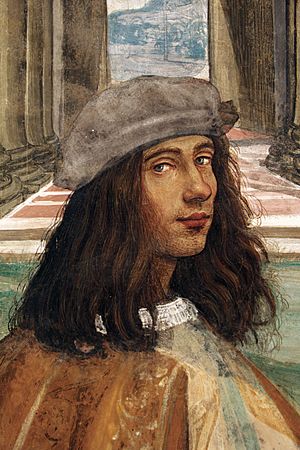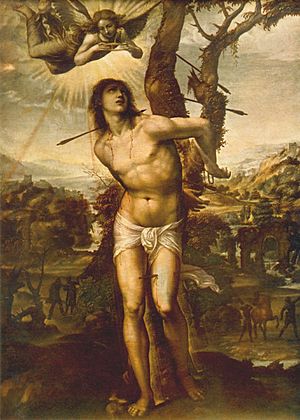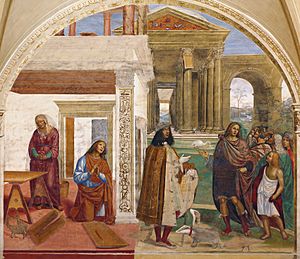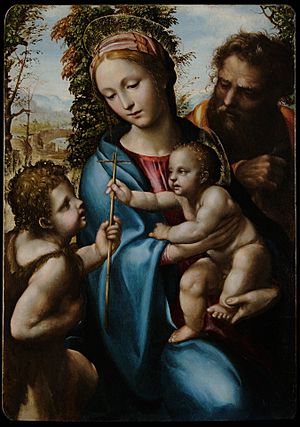Il Sodoma facts for kids
Quick facts for kids
Il Sodoma
|
|
|---|---|

Self-portrait, detail of fresco St Benedict repairs a Broken Colander through Prayer, Chiostro Grande, Abbazia territoriale di Monte Oliveto Maggiore
|
|
| Born |
Giovanni Antonio Bazzi
1477 |
| Died | 14 February 1549 Siena (now Province of Siena, Italy)
|
| Nationality | Italian |
| Education | Martino Spanzotti, Gerolamo Giovenone |
| Movement | High Renaissance Sienese School |
| Patron(s) | Agostino Chigi, Pope Julius II, Pope Leo X |
Il Sodoma (1477 – 14 February 1549) was the nickname for an Italian Renaissance painter named Giovanni Antonio Bazzi. He was known for combining the grand style of the High Renaissance from Rome with the art traditions of the Siena region. Il Sodoma spent most of his career in Siena, but he also worked in Rome for two periods.
Contents
Biography of Il Sodoma
Giovanni Bazzi was born in Vercelli, a city in Piedmont, Italy, in 1477. He first learned painting from an artist named Martino Spanzotti. He also studied with the painter Gerolamo Giovenone.
Giovanni Bazzi learned the strong colors and unique style of the Lombard school. He also picked up some of the artistic ways of Leonardo da Vinci, even though he might not have traveled to Milan where Leonardo worked.
Before 1503, he moved to Siena. There, he started painting large wall paintings (frescoes) for Olivetan monks. He also created small ceiling panels and a long frieze (a decorative band) showing the life of Julius Caesar for Sigismondo Chigi at Palazzo Chigi.
Il Sodoma was one of the first artists to bring the High Renaissance style to Siena, along with Pinturicchio. His first major works were frescoes in the Benedictine monastery of Monte Oliveto Maggiore. These paintings showed the life of St Benedict. Another artist, Luca Signorelli, had started this series in 1498.
Il Sodoma finished the series in 1502. He even included a self-portrait of himself in the paintings.
In 1508, a famous merchant from Siena, Agostino Chigi, invited Il Sodoma to Rome. There, Pope Julius II hired him to work in the Stanza della Segnatura in the Vatican. He painted two large scenes and many decorations. He worked at the same time as the famous artist Raphael.
Before October 1510, Il Sodoma returned to Siena. He painted the outside of Palazzo Chigi with scenes from the Bible and ancient times. This was the first time such a work was seen in Siena. His paintings at this time began to show influences from Florentine art, especially from Fra Bartolommeo.
Agostino Chigi called him back to Rome again. At the Villa Chigi (now called the Villa Farnesina), Il Sodoma worked with Baldassarre Peruzzi. He painted scenes from the life of Alexander the Great. These included Alexander in the Tent of Darius and The Nuptials of the Conqueror with Roxanne. Some people consider The Nuptials of the Conqueror with Roxanne to be his greatest work.
When Leo X became pope in 1513, Il Sodoma gave him a painting called The Death of Lucretia. Pope Leo X gave him a lot of money and made him a cavaliere, which was a special honor.
Il Sodoma returned to Siena and later worked in Pisa, Volterra, and Lucca. He came back to Siena shortly before he died on 14 February 1549. One of his students was known as Giomo del Sodoma.
Artworks by Il Sodoma

Some art experts believe that Il Sodoma's Madonna in the Pinacoteca di Brera shows the direct influence of Leonardo da Vinci.
Among his most famous works are the frescoes he finished in 1526. These are in the chapel of St. Catherine of Siena in the church of San Domenico (Siena). They show the saint in a religious trance, receiving the Eucharist from an angel.
In the Oratory of San Bernardino, he painted scenes from the life of the Virgin Mary. He worked on these with Pacchia and Beccafumi between 1536 and 1538. These frescoes include the Visitation and the Assumption.
In San Francesco, you can find his Deposition from the Cross (1513) and Christ Scourged. Many art critics consider one of these two paintings to be Il Sodoma's masterpiece. In the choir of the Pisa Cathedral is the Sacrifice of Abraham, and in the Uffizi Gallery in Florence, there is a St. Sebastian.
Some of his paintings, like the Holy Family in the Pinacoteca in Siena, have sometimes been mistaken for works by Leonardo da Vinci. His paintings on canvas or wood are rare. There are two of them in the National Gallery, London.
Selected Works
- Flagellation of Christ (1510) - Museum of Fine Arts, Budapest
- The Road to Calvary (1510) - Museum of Fine Arts, Budapest
- Cinuzzi Deposition (before 1513) - Pinacoteca, Siena
- The Death of Lucretia (1513) - Museum of Fine Arts, Budapest
- Saint George and Dragon [1] (1518) - National Gallery of Art, Washington, D.C.
- ... the Sabine Women [2] (1525) - Galleria Nazionale d'Arte Antica, Rome
- St. Sebastian (1525) - Oil on canvas, 206 x 154 cm Galleria degli Uffizi, Florence
- Three Fates [3] (1525) - Galleria Nazionale d'Arte Antica Rome
- Adoration of the Magi (c. 1530) - Sant'Agostino, Siena
- Ordination of Saint Alfonso (1530) - Santo Spirito, Siena
- Crying for dead Christ or Pietà (1533) - Museo Soumaya, Mexico City
- Saint Jerome in Penitence (c.1535-1545) - National Gallery, London
- The Holy Family with Saint John the Baptist and an Angel (c.1535-1545) - Musée des Beaux-Arts, Strasbourg
- The Mystical Marriage of Saint Catherine [4] (1539–1540) - Galleria Nazionale d'Arte Antica, Rome
- Pietà (1540) - Galleria Borghese, Rome
- Sacra Conversazione (1542) - Museo Nazionale di San Matteo, Pisa
- Saint Sebastian with Madonna and Angels (1542) - Museo Nazionale di San Matteo, Pisa
- Allegory of Celestial Love, Chigi-Saracini Collection, Siena
- Leda Galleria Borghese, Roma
- Santa Maddalena (Private collection)
- The Marriage of Alexander and Roxanne - Fresco, Villa Farnesina, Rome
- Procession to Calvary - Museum & Gallery, Inc., South Carolina
- Pietà (Private collection)
Artistic Style and Reputation
The art historian Giorgio Vasari wrote about Il Sodoma in his book Lives of the Artists. Vasari's account of Il Sodoma's life and work was not always positive. He suggested that Il Sodoma was sometimes a careless artist.
Vasari mentioned that Il Sodoma's early success in Siena was partly because there wasn't much competition from other artists. He also claimed that as Il Sodoma got older, he became too "lazy" to plan his frescoes carefully. Instead, he would paint them directly onto the wall.
However, Vasari also admitted that Il Sodoma created some very high-quality works. He also noted that during his lifetime, Il Sodoma's reputation as an artist was very strong.
See also
 In Spanish: Giovanni Antonio Bazzi para niños
In Spanish: Giovanni Antonio Bazzi para niños



